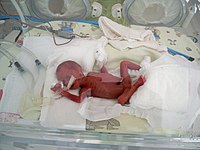
Photo from wikipedia
Preterm infants with bronchopulmonary dysplasia (BPD), and particularly those who develop the most severe forms of chronic lung disease during the neonatal period, are at high risk for poor developmental… Click to show full abstract
Preterm infants with bronchopulmonary dysplasia (BPD), and particularly those who develop the most severe forms of chronic lung disease during the neonatal period, are at high risk for poor developmental outcomes throughout childhood. Infants who require mechanical ventilation at 36 weeks post‐menstrual age have significantly increased odds for cerebral palsy, developmental delay at 2 years, and poor academic achievement and low intelligence quotient in adolescence. Over the past several decades, many therapies and care strategies, including steroids, continuous positive airway pressure, surfactant, and other medications have been introduced into clinical practice. These approaches have changed the epidemiology of BPD in very preterm infants. However, BPD remains common and strongly associated with poor development throughout childhood. Only caffeine has been proven to reduce BPD and improve childhood developmental outcomes. In future research, it will be essential to better understand the developmental sequelae of BPD beyond school age and to test interventions to improve developmental trajectories in this population. As new management strategies for BPD are developed, it will be essential to rigorously evaluate both short‐term and long‐term effects before they are introduced into routine neonatal practice.
Journal Title: Pediatric Pulmonology
Year Published: 2021
Link to full text (if available)
Share on Social Media: Sign Up to like & get
recommendations!